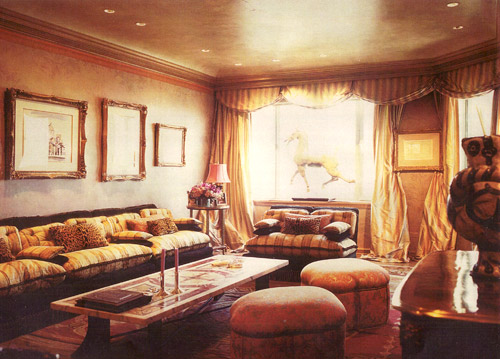|

Mirror-like Luster with Gloss Paint for Ceilings
When the customer wants a highly reflective, mirror-like gloss on a ceiling, what do you do? Be extra-precise in your preparation.
by Liz Trauring
is almost of secondary importance to the skill of the drywaller or plasterer. “The paint is just a few mils thick,” says Doug Wold, president of Queen Anne Painting Co. in Seattle. “It will mirror exactly what is on the substrate, so the surface must be perfect.”
According to Karen McClain, owner of Karen McClain Visuals Inc. in Tacoma, Wash., “The drywall must be a level five, or baby-behind smooth, with no flaws or imperfections, and then it can simply be sprayed with an airless pump.”
When it comes to achieving a mirror-like luster with gloss paint, John Horner, southeast product manager of Scuffmaster Paint agrees that a sheetrock ceiling must have a level five finish.
While there are any number of manufacturers that produce high-gloss paints and clear coats, Horner uses as examples the three, water-based products Scuffmaster makes under the Smooth Pearl label. The first, or basecoat, is the color. The middle level is a clear coat into which a pearlescent is mixed. The topcoat is clear, imparting a consistent sheen across the entire surface. In this way, Horner says, there are two things working for the painter—the sheen from the clear vehicle and the reflective nature of the pearlescenct.
Since any brush cut-ins or stippling from a roller will cause a discernable pattern, the semigloss or gloss latex paint can be applied by spraying with an airless pump. Horner suggests that a 0.015 tip will do. “Everybody has their own preference,”he notes.
Specialty finishes such as Smooth Pearl or any paint with metallic particles may require more control to apply, in which case conventional (compressor and pressure pot) or HVLP sprayers can be used. “This will certainly result in a cleaner application with less overspray, but is slower than using a conventional sprayer, and definitely slower than using an airless,” Horner maintains.
If you don’t have to cover a really big area, or if carpet or furniture is in the room, it may well be worth sacrificing a bit of speed to maximize the amount of protection. Horner definitely recommends using either a conventional air pressure or HVLP with Smooth Pearl for this application.
A mirror-like sheen is not the only reflective effect decorators are asking contractors to apply on ceilings nowadays. Kenneth Wampler at Alpha Workshops in New York City recently completed an apartment ceiling where the owner wanted a smoky reflective surface. He began with a bright yellow and then sponged on Benjamin Moore’s Studio Finish Silver Metallic Glaze. “The ceiling was plaster and had been primed before, so it was fairly smooth,” Wampler explains. “Because the surface wasn’t truly reflective, and had a good deal of texture to it from the sponging, a totally smooth surface wasn’t a necessity. The silver gray/gold of the ceiling was the shiniest surface in the room, reflecting the walls, which after about 12 glazes and a damask stencil applied over the original yellow, ended up being a smoky maize with overtones of purple and pink.”
Mike Hoppe of Faux Masters Studio in Yorba Linda, Calif., has used both lacquer and automotive acrylic urethane in the past to achieve the high-end wet look designers demand. Before the changes in VOC regulations in California he often used nitrocellulose lacquer, which sprays quickly and takes a minimum of four coats to do the job. “Now lacquer isn’t used very often to cover surfaces other than cabinets,” Hoppe says. “But those who do that work will certainly be able to cover a ceiling with it.”
The shiniest, ‘wet look’ surface was achieved using automotive paint. This acrylic urethane is “stinky as hell and requires a lot of solvent,” Hoppe says. “It costs dearly and you can only get it from an automotive specialty store, but there is nothing else that delivers this kind of shine.”
“There was plenty of reflective surface, especially from the swimming pool in the next room, so the ceiling pattern shimmers when you walk across the room,” Selos says.

|

